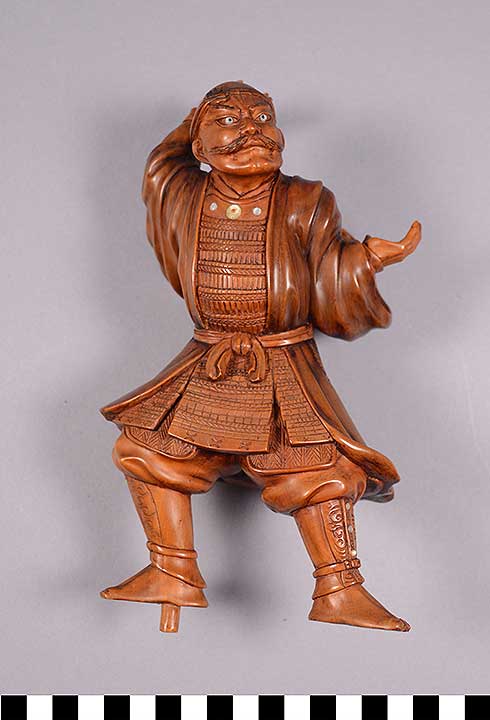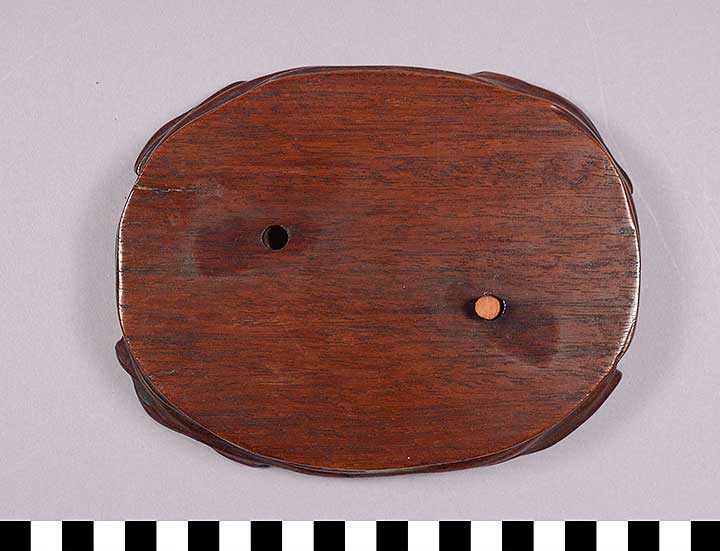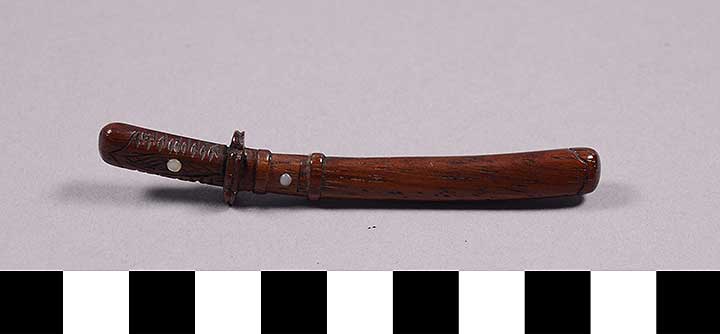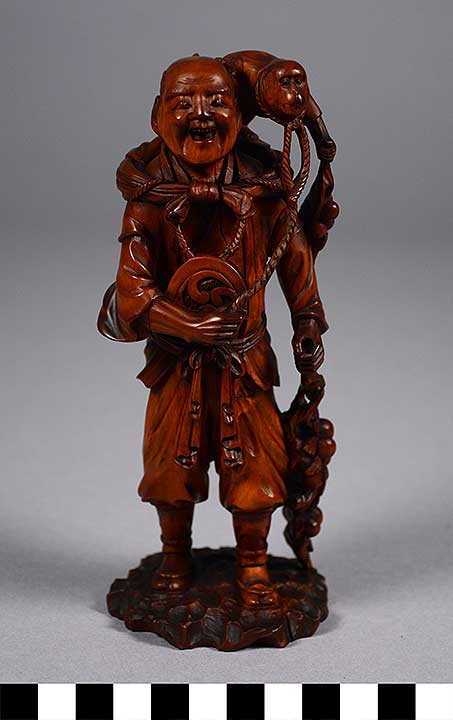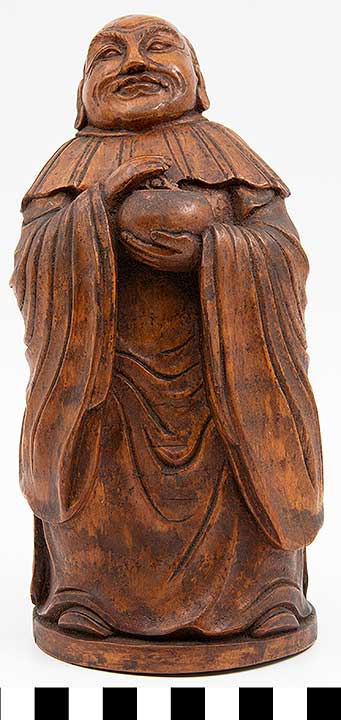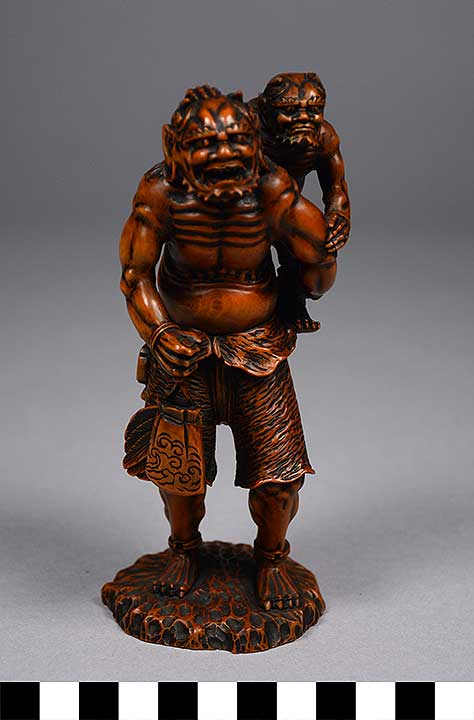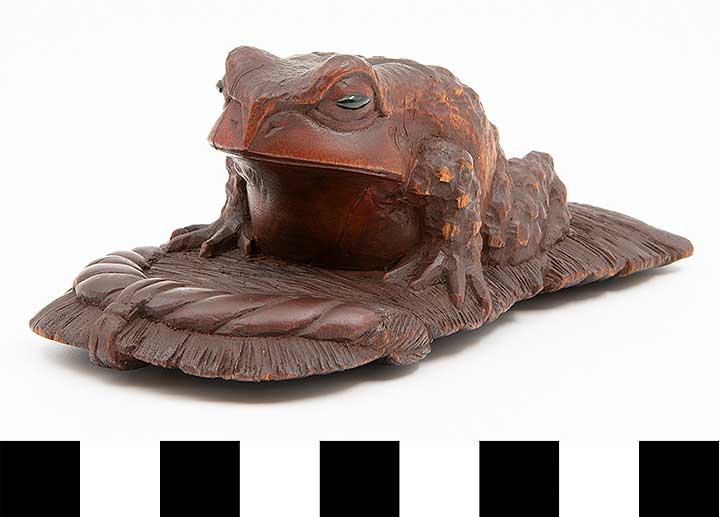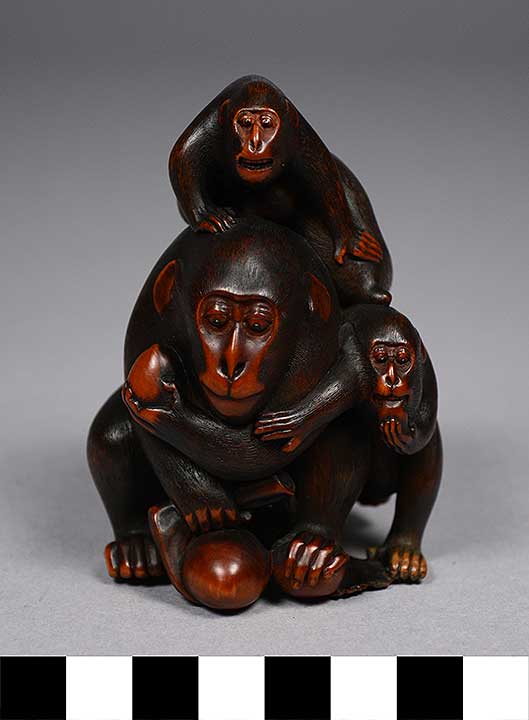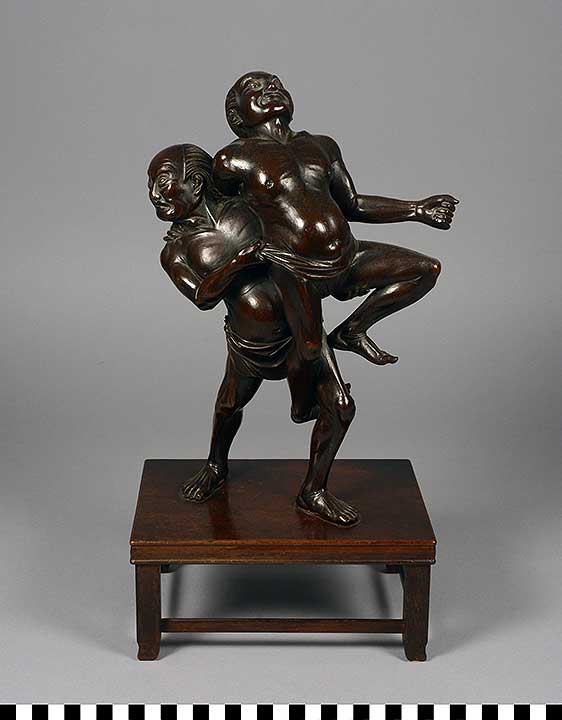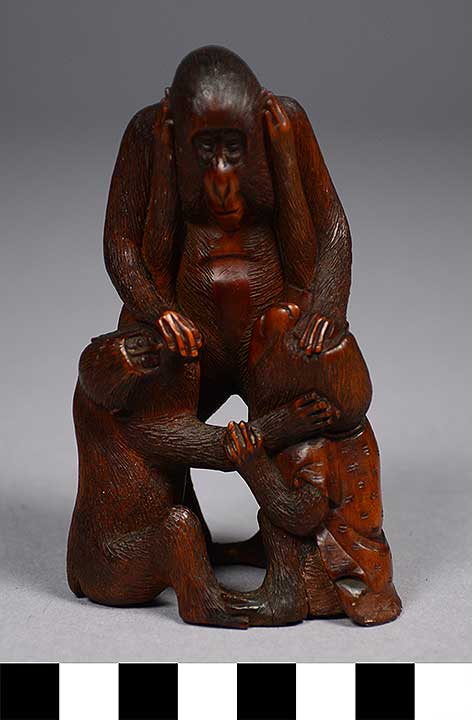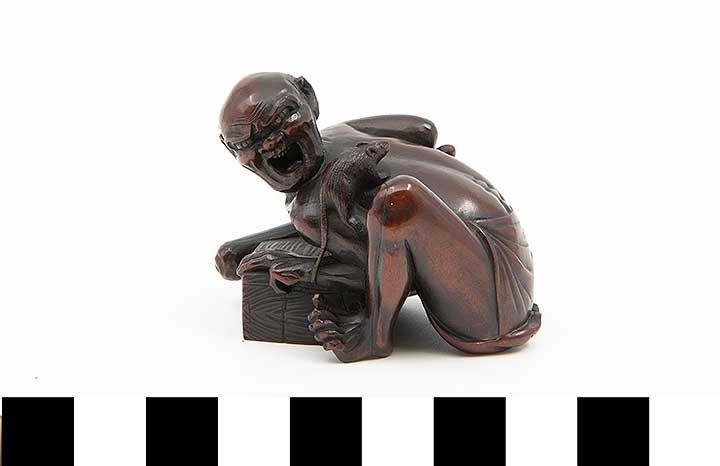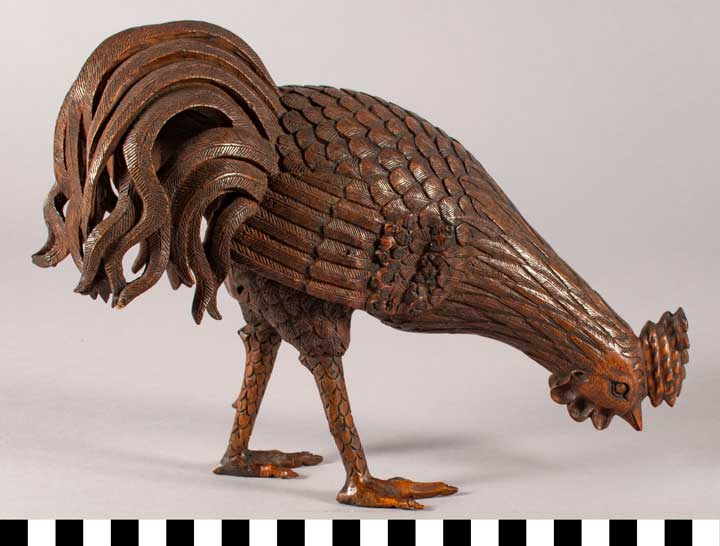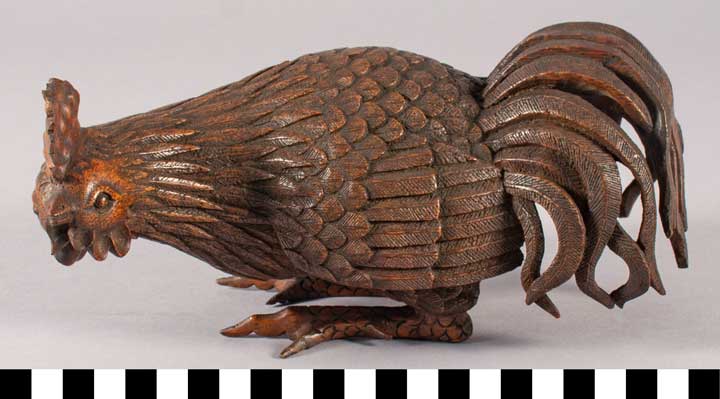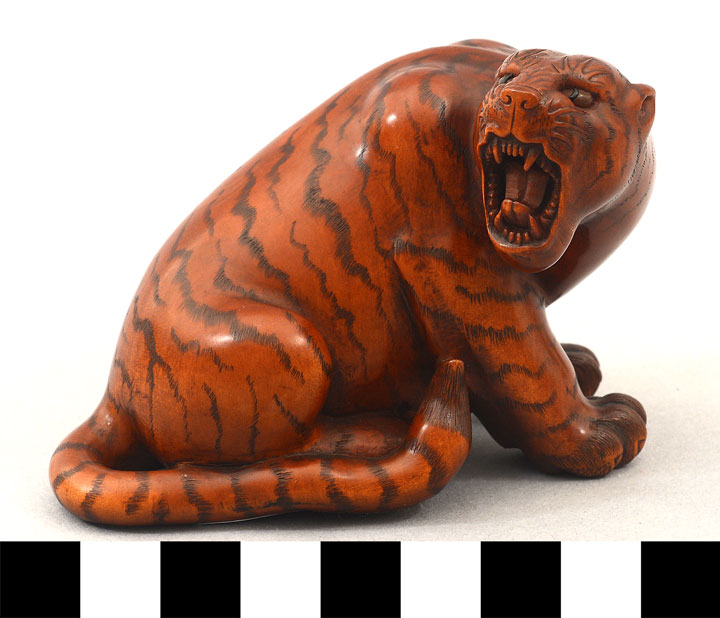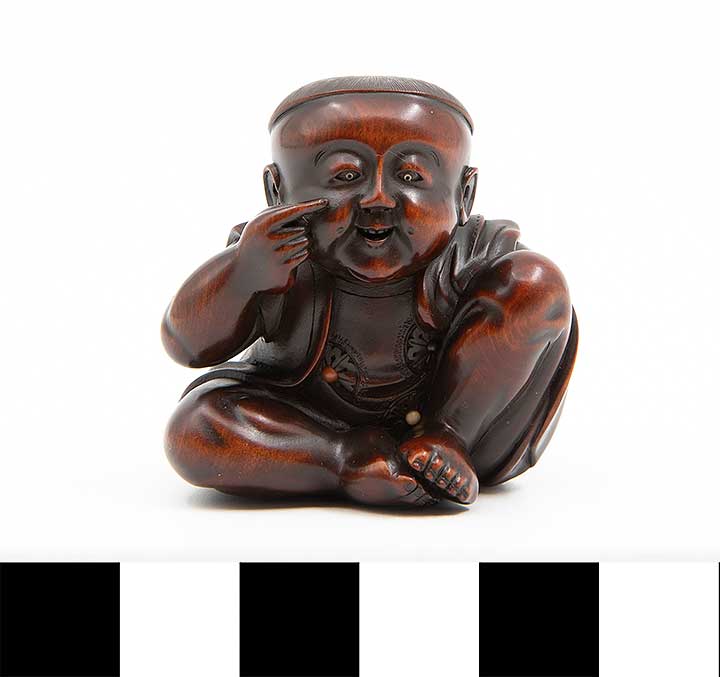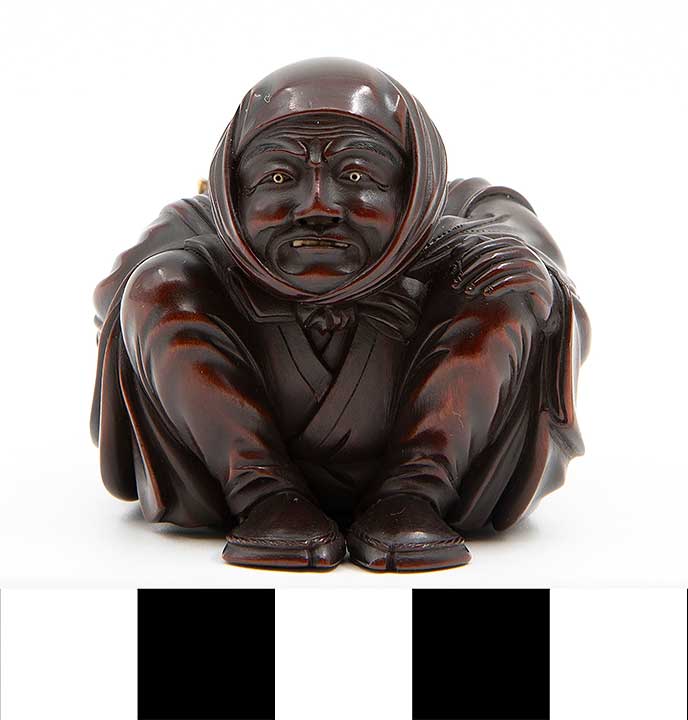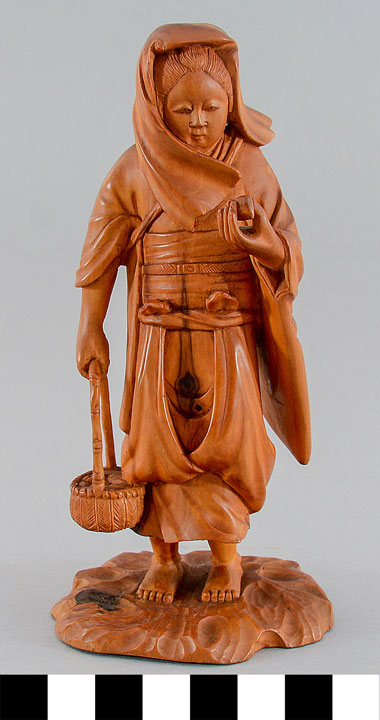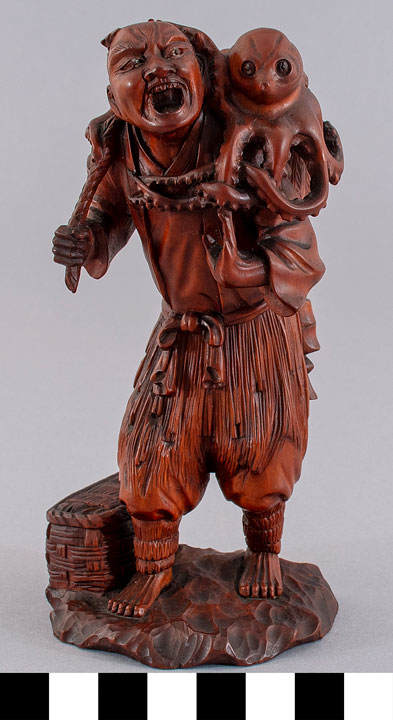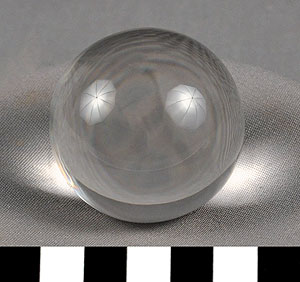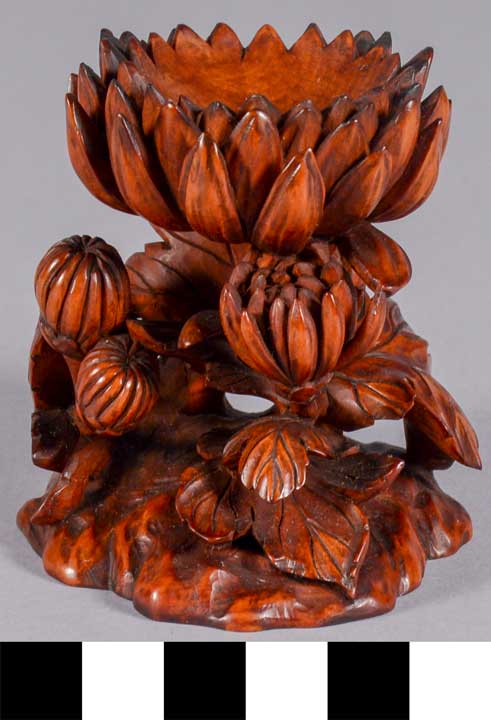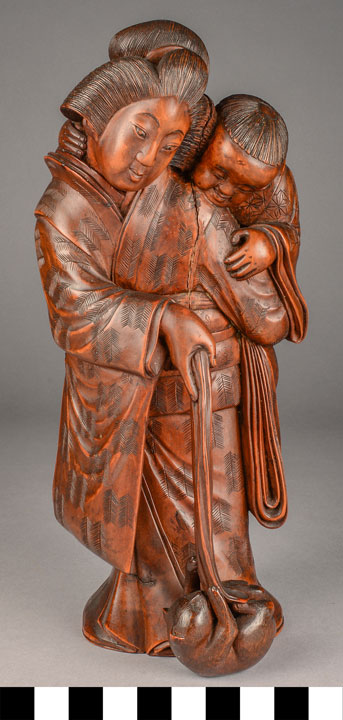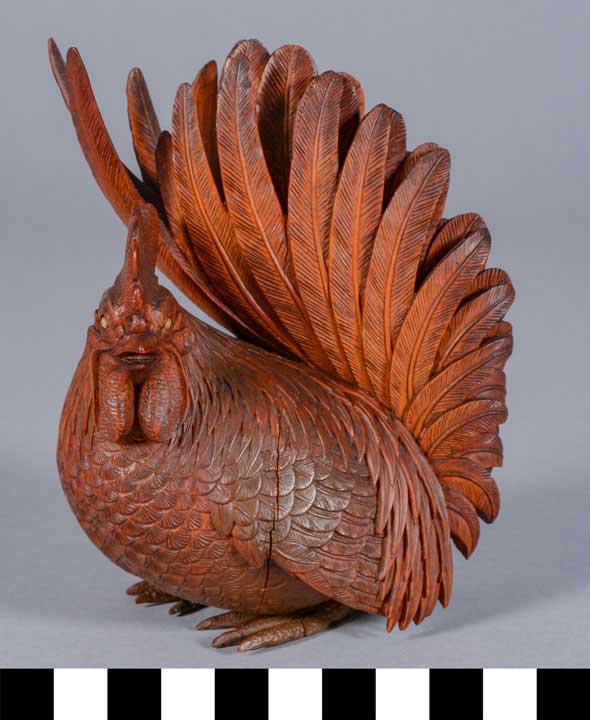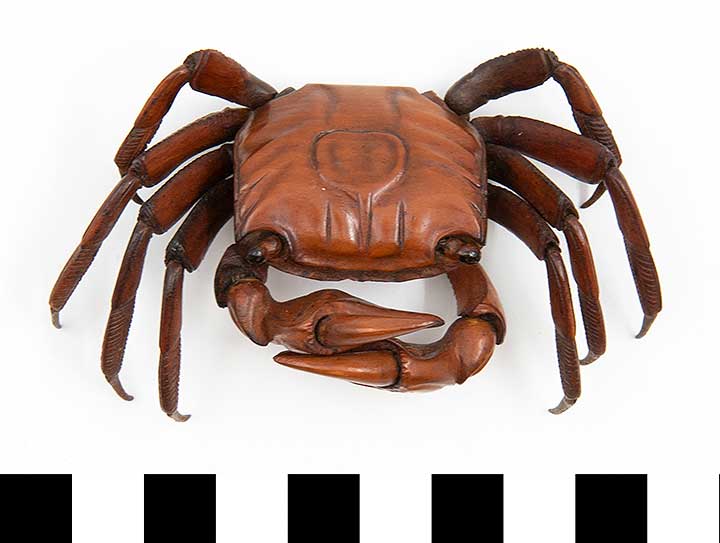Search Results
Displaying Records 1 through 25 of 197 records found
containing the term(s): okimono
Okimono: Samurai1999.13.0001A (1999.13.0001A)
21 x 12.4 x 9.5 cm (310 g)
Location: Asia, East: Japan
Period: Late Meiji Period (1868-1912); 1890s – 1912 CE
Classification/Nomenclature: Communication Artifacts : Art
Description: This is a Japanese boxwood okimono by Kogetsu of a samurai, a member of the military nobility that played a vital role in Japanese feudal society...
Period: Late Meiji Period (1868-1912); 1890s – 1912 CE
Classification/Nomenclature: Communication Artifacts : Art
Description: This is a Japanese boxwood okimono by Kogetsu of a samurai, a member of the military nobility that played a vital role in Japanese feudal society...
Okimono Base1999.13.0001B (1999.13.0001B)
16.2 x 12.5 x 2.8 cm (329 g)
Location: Asia, East: Japan
Period: Late Meiji Period ; 1890s – late 20th century CE
Classification/Nomenclature: Communication Artifacts : Art
Description: This is the base of a Japanese boxwood okimono by Kogetsu of a samurai, a member of the military nobility that played a vital role in Japanese feudal society...
Period: Late Meiji Period ; 1890s – late 20th century CE
Classification/Nomenclature: Communication Artifacts : Art
Description: This is the base of a Japanese boxwood okimono by Kogetsu of a samurai, a member of the military nobility that played a vital role in Japanese feudal society...
Okimono: Sword1999.13.0001C (1999.13.0001C)
8.6 x 1.3 x .8 cm (4 g)
Location: Asia, East: Japan
Period: Late Meiji Period (1868-1912); 1890s – 1912 CE
Classification/Nomenclature: Communication Artifacts : Art
Description: This is the sword of a Japanese boxwood okimono by Kogetsu of a samurai, a member of the military nobility that played a vital role in Japanese feudal society...
Period: Late Meiji Period (1868-1912); 1890s – 1912 CE
Classification/Nomenclature: Communication Artifacts : Art
Description: This is the sword of a Japanese boxwood okimono by Kogetsu of a samurai, a member of the military nobility that played a vital role in Japanese feudal society...
Okimono: Monkey Trainer1999.13.0002 (1999.13.0002)
15.5 x 6.8 x 6.6 cm (175 g)
Location: Asia, East: Japan
Period: Late Meiji Period (1868-1912); 1890s – 1912 CE
Classification/Nomenclature: Communication Artifacts : Art
Description: This Japanese boxwood okimono by Kogetsu depicts a monkey trainer and his monkey represents a form of entertainment that is frequently featured in Japanese art from the Edo period to the 20th century...
Period: Late Meiji Period (1868-1912); 1890s – 1912 CE
Classification/Nomenclature: Communication Artifacts : Art
Description: This Japanese boxwood okimono by Kogetsu depicts a monkey trainer and his monkey represents a form of entertainment that is frequently featured in Japanese art from the Edo period to the 20th century...
Carving: Foreigner1999.13.0004 (1999.13.0004)
21.5 x 12.2 x 11.6 cm (574 g)
Location: Asia, East: Japan
Period: Edo; 18th century
Classification/Nomenclature: Communication Artifacts : Art
Description: A rare Japanese bamboo carving of a "foreigner", 9" H. probably Edo, 18th c., finely detailed and carved in high relief...
Period: Edo; 18th century
Classification/Nomenclature: Communication Artifacts : Art
Description: A rare Japanese bamboo carving of a "foreigner", 9" H. probably Edo, 18th c., finely detailed and carved in high relief...
Okimono: Raiden, Shinto God of Thunder, and Son1999.13.0007 (1999.13.0007)
15.3 x 7.7 x 6.9 cm (150 g)
Location: Asia, East: Japan
Period: Meiji Period (1868-1912); 1868 – 1912
Classification/Nomenclature: Communication Artifacts : Art
Description: This is a Japanese boxwood okimono of Raiden, the Shinto god of thunder, and his son Raitaro. Raiden is often depicted to have demonic features and his most common attribute is a drum or wheel of drums to create the sound of thunder...
Period: Meiji Period (1868-1912); 1868 – 1912
Classification/Nomenclature: Communication Artifacts : Art
Description: This is a Japanese boxwood okimono of Raiden, the Shinto god of thunder, and his son Raitaro. Raiden is often depicted to have demonic features and his most common attribute is a drum or wheel of drums to create the sound of thunder...
Okimono: Toad1999.13.0008 (1999.13.0008)
15.5 x 8.6 x 6.2 cm (131 g)
Location: Asia, East: Japan
Period: Late Edo Period (1603-1868) - Early Meiji Period (1868-1912); 19th century
Classification/Nomenclature: Communication Artifacts : Art
Description: The toad is credited with magic powers and is, therefore, often the subject of Japanese arts as is the case with this boxwood okimono...
Period: Late Edo Period (1603-1868) - Early Meiji Period (1868-1912); 19th century
Classification/Nomenclature: Communication Artifacts : Art
Description: The toad is credited with magic powers and is, therefore, often the subject of Japanese arts as is the case with this boxwood okimono...
Okimono: Entwined Sambiki Saru (Wise Monkeys)1999.13.0010 (1999.13.0010)
7.6 x 6.6 x 6.5 cm (104 g)
Location: Asia, East: Japan
Period: Edo Period (1603-1868); Mid 19th century
Classification/Nomenclature: Communication Artifacts : Art
Description: This Japanese boxwood okimono depicts three monkeys representing Sambiki Saru (Wise Monkeys). The Saru is one of the Zodiac and frequently plays a role in legend...
Period: Edo Period (1603-1868); Mid 19th century
Classification/Nomenclature: Communication Artifacts : Art
Description: This Japanese boxwood okimono depicts three monkeys representing Sambiki Saru (Wise Monkeys). The Saru is one of the Zodiac and frequently plays a role in legend...
Okimono: Sumo Wrestlers1999.13.0012 (1999.13.0012)
38.6 x 20.9 x 14.5 cm (984 g)
Location: Asia, East: Japan
Period: Late Edo Period (1603-1868) - Early Meiji Period (1868-1912); 19th Century
Classification/Nomenclature: Communication Artifacts : Art
Description: The classic Kawazu throw of sumo wrestling is pictured in this Japanese okimono. Sumo was established over 2000 years ago as a Shinto ritual and and is depicted in a variety of decorative arts including Ukiyo-e (colorful woodblock prints)...
Period: Late Edo Period (1603-1868) - Early Meiji Period (1868-1912); 19th Century
Classification/Nomenclature: Communication Artifacts : Art
Description: The classic Kawazu throw of sumo wrestling is pictured in this Japanese okimono. Sumo was established over 2000 years ago as a Shinto ritual and and is depicted in a variety of decorative arts including Ukiyo-e (colorful woodblock prints)...
Okimono: Entwined Sambiki Saru (Wise Monkeys)1999.13.0019 (1999.13.0019)
9.4 x 6.5 x 5 cm (84 g)
Location: Asia, East: Japan
Period: Meiji Period (1868-1912); 1880
Classification/Nomenclature: Communication Artifacts : Art
Description: This Japanese boxwood okimono depicts three apes representing Sambiki Saru (Wise Monkeys), the attendants of Koshin, the god of the roads...
Period: Meiji Period (1868-1912); 1880
Classification/Nomenclature: Communication Artifacts : Art
Description: This Japanese boxwood okimono depicts three apes representing Sambiki Saru (Wise Monkeys), the attendants of Koshin, the god of the roads...
Okimono: Rat Catcher1999.13.0020 (1999.13.0020)
6.8 x 4.9 x 4.9 cm (45 g)
Location: Asia, East: Japan
Period: Meiji Period (1868-1912); 1868 - 1912
Classification/Nomenclature: Communication Artifacts : Art
Description: This Japanese boxwood okimono by Masayume depicts a rat catcher in the act of catching a rat. The rat is associated with industry, fertility, and good luck and are often associated with the god Daikoku as his companions...
Period: Meiji Period (1868-1912); 1868 - 1912
Classification/Nomenclature: Communication Artifacts : Art
Description: This Japanese boxwood okimono by Masayume depicts a rat catcher in the act of catching a rat. The rat is associated with industry, fertility, and good luck and are often associated with the god Daikoku as his companions...
Okimono: Standing Cockerel1999.13.0029A (1999.13.0029A)
25.6 x 19.9 x 10.2 cm (386 g)
Location: Asia, East: Japan
Period: Late Edo Period (1603-1868); 1800-1850 CE
Classification/Nomenclature: Communication Artifacts : Art
Description: This is a Japanese okimono of a standing cockerel (rooster), an animal of the duodenary cycle that is often featured in art...
Period: Late Edo Period (1603-1868); 1800-1850 CE
Classification/Nomenclature: Communication Artifacts : Art
Description: This is a Japanese okimono of a standing cockerel (rooster), an animal of the duodenary cycle that is often featured in art...
Okimono: Crouching Cockerel1999.13.0029B (1999.13.0029B)
24 x 14.1 x 11.5 cm (359 g)
Location: Asia, East: Japan
Period: Late Edo Period (1603-1868); 1800-1850 CE
Classification/Nomenclature: Communication Artifacts : Art
Description: This is a Japanese okimono of a standing cockerel (rooster), an animal of the duodenary cycle that is often featured in art...
Period: Late Edo Period (1603-1868); 1800-1850 CE
Classification/Nomenclature: Communication Artifacts : Art
Description: This is a Japanese okimono of a standing cockerel (rooster), an animal of the duodenary cycle that is often featured in art...
Okimono: Tiger2000.20.0002 (2000.20.0002)
8.7 x 6.1 x 5.5 cm (89 g)
Location: Asia, East: Japan
Period: Late Edo Period (1603-1868) - Early Meiji Period (1868-1912); 19th century
Classification/Nomenclature: Communication Artifacts : Art
Description: This is the base of a Japanese boxwood okimono of a tiger, an animal revered in Asian culture as a symbol of strength and courage...
Period: Late Edo Period (1603-1868) - Early Meiji Period (1868-1912); 19th century
Classification/Nomenclature: Communication Artifacts : Art
Description: This is the base of a Japanese boxwood okimono of a tiger, an animal revered in Asian culture as a symbol of strength and courage...
Okimono-Style Netsuke: Boy2000.20.0004 (2000.20.0004)
5.2 x 5.2 x 5.1 cm (45 g)
Location: Asia, East: Japan
Period: Edo Period (1603-1868); 1800-1825
Classification/Nomenclature: Personal Artifacts : Personal Gear : Personal Carrying & Storage Gear
Description: This is a Japanese netsuke of a boy. The netsuke, literally meaning root (ne) and attached or hung (tsuke) is a clothing fastener which is situated on the upper end of the kimono sash (obi)...
Period: Edo Period (1603-1868); 1800-1825
Classification/Nomenclature: Personal Artifacts : Personal Gear : Personal Carrying & Storage Gear
Description: This is a Japanese netsuke of a boy. The netsuke, literally meaning root (ne) and attached or hung (tsuke) is a clothing fastener which is situated on the upper end of the kimono sash (obi)...
Okimono-Style Netsuke: Traveler2000.20.0005 (2000.20.0005)
6.2 x 5.3 x 5 cm (61 g)
Location: Asia, East: Japan
Period: Edo Period (1603-1868); 1800-1825
Classification/Nomenclature: Personal Artifacts : Personal Gear : Personal Carrying & Storage Gear
Description: This is a Japanese netsuke of a traveler. The netsuke, literally meaning root (ne) and attached or hung (tsuke) is a clothing fastener which is situated on the upper end of the kimono sash (obi)...
Period: Edo Period (1603-1868); 1800-1825
Classification/Nomenclature: Personal Artifacts : Personal Gear : Personal Carrying & Storage Gear
Description: This is a Japanese netsuke of a traveler. The netsuke, literally meaning root (ne) and attached or hung (tsuke) is a clothing fastener which is situated on the upper end of the kimono sash (obi)...
Okimono: Woman with Basket of Fruit2000.20.0006 (2000.20.0006)
14.9 x 7.4 x 6.9 cm (134 g)
Location: Asia, East: Japan
Period: Meiji Period (1868-1912); 1868 - 1912 CE
Classification/Nomenclature: Communication Artifacts : Art
Description: This is a Japanese boxwood okimono of a woman with a fruit basket. While the carving is signed at the bottom, the author is unknown...
Period: Meiji Period (1868-1912); 1868 - 1912 CE
Classification/Nomenclature: Communication Artifacts : Art
Description: This is a Japanese boxwood okimono of a woman with a fruit basket. While the carving is signed at the bottom, the author is unknown...
Okimono: Fisherman2000.20.0007 (2000.20.0007)
13.8 x 7.4 x 7.3 cm (196 g)
Location: Asia, East: Japan
Period: Meiji Period (1868-1912); 1868 - 1912
Classification/Nomenclature: Communication Artifacts : Art
Description: This is a Japanese boxwood okimono of a fisherman with an octopus on his shoulder. It is created with a yellowish brown hardwood (boxwood)...
Period: Meiji Period (1868-1912); 1868 - 1912
Classification/Nomenclature: Communication Artifacts : Art
Description: This is a Japanese boxwood okimono of a fisherman with an octopus on his shoulder. It is created with a yellowish brown hardwood (boxwood)...
Okimono: Kannon (Guanyin, Kuanyin, Avalokiteshvara)2001.07.0001 (2001.07.0001)
36.1 x 8.8 x 7.1 cm (637 g)
Location: Asia, East: Japan
Period: Meiji Period (1868-1912); Late 19th Century
Classification/Nomenclature: Communication Artifacts : Art
Description: This is a Japanese okimono of Kannon (Guanyin), the Japanese name for the Bodhisattva Avalokitesvara...
Period: Meiji Period (1868-1912); Late 19th Century
Classification/Nomenclature: Communication Artifacts : Art
Description: This is a Japanese okimono of Kannon (Guanyin), the Japanese name for the Bodhisattva Avalokitesvara...
Crystal Ball2001.07.0003A (2001.07.0003A)
4.8 x 4.8 x 4.7 cm (154 g)
Location: Asia, East: Japan
Period: Meiji Period (1868-1912); 19th Century
Classification/Nomenclature: Communication Artifacts : Art
Description: "A Japanese boxwood stand, carved to form chrysanthemums, foliage and buds, surmounted by a crystal ball...
Period: Meiji Period (1868-1912); 19th Century
Classification/Nomenclature: Communication Artifacts : Art
Description: "A Japanese boxwood stand, carved to form chrysanthemums, foliage and buds, surmounted by a crystal ball...
Crystal Ball Stand2001.07.0003B (2001.07.0003B)
6.9 x 6.4 x 5.9 cm (63 g)
Location: Asia, East: Japan
Period: Meiji Period (1868-1912); 19th Century
Classification/Nomenclature: Communication Artifacts : Art
Description: "A Japanese boxwood stand, carved to form chrysanthemums, foliage and buds, surmounted by a crystal ball...
Period: Meiji Period (1868-1912); 19th Century
Classification/Nomenclature: Communication Artifacts : Art
Description: "A Japanese boxwood stand, carved to form chrysanthemums, foliage and buds, surmounted by a crystal ball...
Okimono: Bijin (Beautiful Woman) with Child2001.07.0004 (2001.07.0004)
22 x 9.6 x 8.2 cm (725 g)
Location: Asia, East: Japan
Period: Meiji Period (1868-1912); Late 19th Century
Classification/Nomenclature: Communication Artifacts : Art
Description: This is a Japanese boxwood okimono of a bijin (beautiful woman) with her child, both watching their cat play...
Period: Meiji Period (1868-1912); Late 19th Century
Classification/Nomenclature: Communication Artifacts : Art
Description: This is a Japanese boxwood okimono of a bijin (beautiful woman) with her child, both watching their cat play...
Okimono: Cockerel2001.07.0006A (2001.07.0006A)
12.6 x 8.9 x 7.1 cm (274 g)
Location: Asia, East: Japan
Period: Meiji Period (1868-1912); Circa 1868-1912
Classification/Nomenclature: Communication Artifacts : Art
Description: This is a Japanese okimono of a cockerel looking on. This carving is a part of a hen and cockeral pairing...
Period: Meiji Period (1868-1912); Circa 1868-1912
Classification/Nomenclature: Communication Artifacts : Art
Description: This is a Japanese okimono of a cockerel looking on. This carving is a part of a hen and cockeral pairing...
Okimono: Hen2001.07.0006B (2001.07.0006B)
9.9 x 8.3 x 4.9 cm (95 g)
Location: Asia, East: Japan
Period: Meiji Period (1868-1912); Circa 1868-1912
Classification/Nomenclature: Communication Artifacts : Art
Description: This is a Japanese okimono of a hen picking at seeds. This carving is a part of a hen and cockeral pairing...
Period: Meiji Period (1868-1912); Circa 1868-1912
Classification/Nomenclature: Communication Artifacts : Art
Description: This is a Japanese okimono of a hen picking at seeds. This carving is a part of a hen and cockeral pairing...
Okimono: Crab2001.07.0010A (2001.07.0010A)
8.8 x 5.2 x 3 cm (18 g)
Location: Asia, East: Japan
Period: Meiji Period (1868-1912); 1868 - 1912
Classification/Nomenclature: Communication Artifacts : Art
Description: This is a Japanese okimono of a crab signed by Ikkan. In legend, the Heike crabs of Akamaganseki are tiny crabs where the ghostly remains of the warriors killed at the Battle of Dan-no-ura (1185) reside...
Period: Meiji Period (1868-1912); 1868 - 1912
Classification/Nomenclature: Communication Artifacts : Art
Description: This is a Japanese okimono of a crab signed by Ikkan. In legend, the Heike crabs of Akamaganseki are tiny crabs where the ghostly remains of the warriors killed at the Battle of Dan-no-ura (1185) reside...
Search Examples
Explore More
Access the public portions of the catalog records for the approximately 50,000 cultural and ethnographic objects in the Museum's Artifact Collection.
